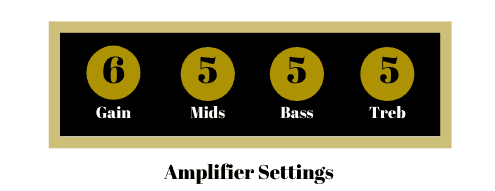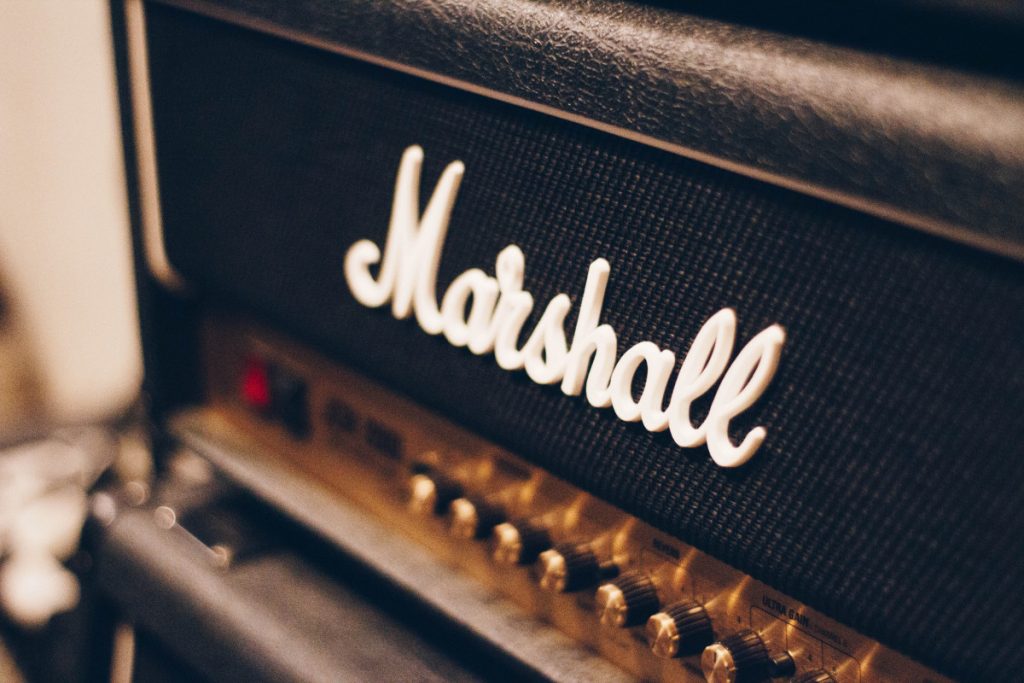If you want to sound like Billie Joe Armstrong on the guitar, then you’ll need to nail the amp settings. But trying to dial in the perfect amp settings to sound like a specific band can be difficult if you don’t have the same equipment.
In this article, I’ll be talking about how to sound like Green Day with your rig, by focusing on your amp. Of course, without the same equipment, it can be difficult to achieve the perfect tone.
However, this article will give you a good starting point, and then I’ll jump into the adjustments you can make to get closer to the Green Day sound. So let’s get started.
The Quick Answer
To sound like Green Day on guitar, start with the following amp settings.
- Gain: 6
- Treble: 5
- Bass: 5
- Mids: 5
The Basics
To achieve a similar tone to Billie Joe Armstrong, then you’ll need to consider the gain, EQ (bass, mids and treble) and also some effects like reverb and delay. So let’s take a look at each of these settings individually.
Gain
Some amp settings have a gain or overdrive control, and others don’t. It depends what type of amp you’re using. There are two main types of amp: tube (valve) and solid state.
Solid state amps will have a gain setting to give the tone some crunch and distortion. Tube amps don’t have this control and instead rely on the volume to give this effect. So if you’re using a tube or valve amp, then you’ll need to turn the volume up until the tone starts to distort and break up.
Most people reading this will have a solid state amp with a specific gain setting though. Simply search the make and model of your amp if you’re unsure to find out.
A lot of players make the mistake of dialling the gain up too high. This causes the tone to sound too muddy and more metal than punk.
You want to get the balance with the gain. It usually is around midway on most amplifiers. Turn it up just enough so that you get some crunch, but not so much that it sounds muffled.
EQ (Bass, Mids, Treble)
Some amplifiers have a “tone” or “EQ” control, and others have specific bass, mids and treble controls. These both have the same intention, to control the frequencies which are played through the speaker.
If you’re amp has different names for these controls (contour is a common one), then take a look at this complete guide to amp settings which will explain what each control does and help translate some of the common terms for your amplifier.
Green Day’s tone is fairly balanced, so having all your controls at midway is a great place to start for most amplifiers. So set your bass, mids and treble to 6 o’clock, or your EQ or tone control to 6 o’clock if that’s what your amp has instead.
Here are a few rules to remember about these controls:
- Treble increases the sharpness and clarity of the tone.
- Bass gives the tone a “boomier” sound.
- Mids increases the depth of the tone so it doesn’t get lost amongst the other instruments.
- Tone and EQ controls are an all-in-one control for the bass, mids and treble. Turn it counter-clockwise to have the effect of increasing the bass and decreasing the treble. Turn it clockwise to increase the treble and decrease the bass.
Reverb and Delay
Some amps have reverb and delay controls built in, and some don’t and require you to use a pedal to get these kind of effects.
Don’t worry if your amp doesn’t have these controls. It’s still possible to get pretty close to the tone without these effects. But if you have no idea what I’m talking about here, then check out this article I’ve written on reverb and delay to learn more.
If you’re planning to use reverb, then it should be on around 1/4 the way up. The delay effect is used more sparingly in certain tracks.
Different brands also have different controls which need to be addressed. Make sure you check out the brand-specific amp controls guide which is relevant to you, to get the most from your rig:
- Fender Amp Settings
- Marshall Amp Settings
- Boss Amp Settings
- Orange Amp Settings
- Line 6 Amp Settings
- Vox Amp Settings
The Story So Far…
So far, you should have a good starting point for your EQ settings, reverb and gain control. Here’s a quick diagram to summarise. Note: it’s assumed that 10 is the max setting.

If you really want to improve your guitar playing then I recommend checking out Guitareo. You can sign up for a free 30-day trial here to get access to all the online lessons and start making real progress today
Amp Settings for Popular Green Day Songs
Now we’ve been through the basics, I thought it’d be a good idea to go through some more specific amp settings for some of Green Day’s most popular songs.
Remember, that this is just a starting point. If you’re struggling getting the tone closer to Billie Joe Armstrong’s signature punk rock sound, then skip ahead to the next section where I go through some common issues and how to fix them.
Basket Case
This was one of Green Day’s earlier classics from their third studio album released in 1994. It’s got a very classic punk rock tone with a lot of palm muting in the intro.
To achieve this, you’ll need the gain to be high enough so that you get the crunch, but not too high that the power chords sound muffled. You’ll also need a decent bit of bass and mids to give the riffs a beefier tone. Here’s where to start.
- Gain: 6
- Bass: 6
- Mids: 6
- Treble: 5
American Idiot
American Idiot has one of Green Day’s most iconic riffs and comes from the band’s 7th studio album released in 2004.
Again, it has a classic punk rock tone, but the gain is dialed back a bit to give it a crunchy and gritty quality, rather than smoother distortion. You’ll probably need to turn the volume up a bit more so you don’t lose the impact that comes with a lower gain setting. Try having the treble higher and bass lower, but keep the mids moderately high.
Here’s where to start with the amp settings for American Idiot.
- Gain: 4
- Bass: 4
- Mids: 6
- Treble: 6
Wake Me Up When September Ends
Wake Me Up When September Ends was released in 2005, and the first half features an acoustic guitar, and then switches to a heavier electric guitar sound. The guitar in this track is less about providing a catchy riff (like in American Idiot) and more about providing the mid-range frequencies.
So, you’ll need a decent bit of gain to give it a smoother distorted tone, and also enough bass and mids to back it up. The treble shouldn’t be too high or you risk it overpowering the vocals.
Here’s where to start with the amp settings for Wake Me Up When September Ends.
- Gain: 6
- Bass: 6
- Mids: 7
- Treble: 4
Boulevard of Broken Dreams
This brings us to the final song on the list, Boulvard of Broken Dreams. The intro is a little more complicated here, as you’ll need a delay pedal to achieve this effect. However, the chorus is more simple.
You’ll need a fair amount of gain and mids to give the tone plenty of depth. Balance the bass and treble to make sure it doesn’t sound too heavy and muffled, or too harsh.
Here’s where to start with the amp settings for Boulevard of Broken Dreams.
- Gain: 6
- Bass: 5
- Mids: 6
- Treble: 5

Common Problems
There are a few main issues that players tend to face when trying to dial in their amp settings to sound more like Green Day. Here are the most common problems, and how to tackle them.
Make these adjustments individually and see the effect it has on your tone. Don’t try them all at once or you’ll struggle to pinpoint the issue.
Muddy Tone
When trying to sound like Billie Joe Armstrong on the guitar, a lot of people struggle with achieving enough depth and gain, without creating a muddy sound. If this is something you’re struggling with, then try the following tweaks.
- Turn the bass down slightly
- Turn the gain down slightly, and increase the volume to counteract
- Increase the treble
Check out my guide on how to fix a muddy amp for more causes and fixes.
Weak and Thin Tone
A lot of players also struggle with achieving enough depth to their tone so that it doesn’t sound too brittle. Here are some adjustments you can make to your amp settings to deal with this problem.
- Increase the bass and mids
- Increase the gain
Chugging Issues
A lot of Green Day songs use the palm muting technique to have this “chugging effect”. Not only is this a difficult skill to master when you’re first trying, but it’s also difficult to get the amp settings right so that you achieve this classic punk rock effect.
Most commonly, you’ll face one of two problems.
- Thin, weak and quiet chugging
- A muffled effect where the “chugs” sound mashed together
If you’re struggling with issue #1, when follow the steps we’ve just discussed on battling a weak and thin tone because these will likely solve this issue as well.
If you’re struggling with issue #2, then increase the treble and decrease the bass as discussed in the section on how to clean up a muddy sounding tone.
Frequently Asked Questions
Here are some of the most common questions players ask when trying to sound like Green Day on guitar!
What Amp Does Green Day Use?
Green Day’s Billie Joe Armstrong has often used modified Marshall head units to achieve his signature tone. Take a look at the video below to learn more.
What Guitar Does Billie Joe Armstrong Play?
The most famous guitar Green Day’s front man has used is the Fernandes Stratocaster with a H-S-S pickup configuration (the Seymour Duncan humbucker in the bridge is angled). Billie Joe Armstrong also often plays a Gibson Les Paul Junior with a single humbucker pickup in the bridge position.
What Pedal Effects Do Green Day Use?
Billie Joe Armstrong is not known for using a lot of pedal effects however Green Day have been known to use a Tremolo pedal (Boss TR-2), Flanger pedal (Ibanez CF-7) and Overdrive Pedals (Ibanez Tube Screamer TS-9 and Boss BD-2 Blues Driver).
Looking for more punk songs? Check out my complete guide to punk amp settings for more examples.
Thanks for reading! I hope you’ve found this article helpful. Take a look at the rest of the website to learn more about getting the perfect tone.
